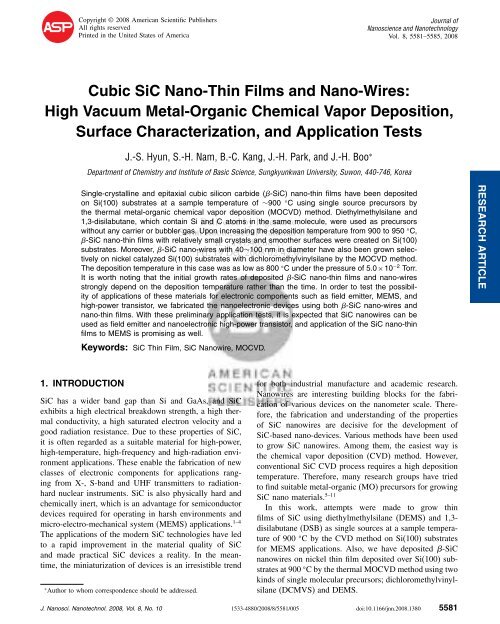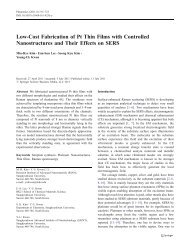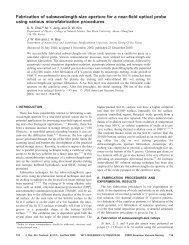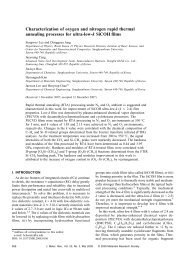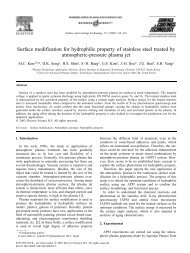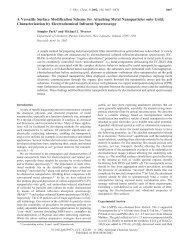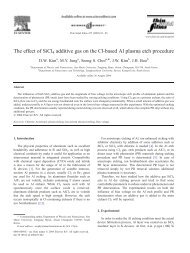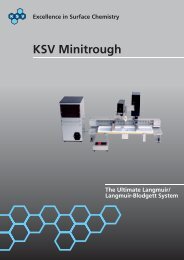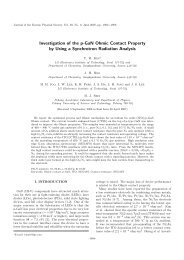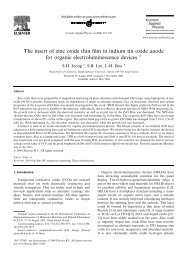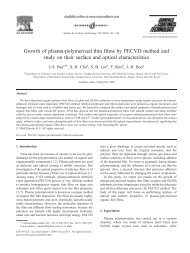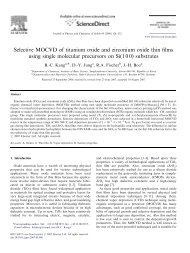Cubic SiC Nano-Thin Films and Nano-Wires: High Vacuum Metal ...
Cubic SiC Nano-Thin Films and Nano-Wires: High Vacuum Metal ...
Cubic SiC Nano-Thin Films and Nano-Wires: High Vacuum Metal ...
Create successful ePaper yourself
Turn your PDF publications into a flip-book with our unique Google optimized e-Paper software.
Copyright © 2008 American Scientific Publishers<br />
All rights reserved<br />
Printed in the United States of America<br />
Journal of<br />
<strong>Nano</strong>science <strong>and</strong> <strong>Nano</strong>technology<br />
Vol.8, 5581–5585, 2008<br />
<strong>Cubic</strong> <strong>SiC</strong> <strong>Nano</strong>-<strong>Thin</strong> <strong>Films</strong> <strong>and</strong> <strong>Nano</strong>-<strong>Wires</strong>:<br />
<strong>High</strong> <strong>Vacuum</strong> <strong>Metal</strong>-Organic Chemical Vapor Deposition,<br />
Surface Characterization, <strong>and</strong> Application Tests<br />
J.-S. Hyun, S.-H. Nam, B.-C. Kang, J.-H. Park, <strong>and</strong> J.-H. Boo ∗<br />
Department of Chemistry <strong>and</strong> Institute of Basic Science, Sungkyunkwan University, Suwon, 440-746, Korea<br />
Single-crystalline <strong>and</strong> epitaxial cubic silicon carbide (-<strong>SiC</strong>) nano-thin films have been deposited<br />
on Si(100) substrates at a sample temperature of ∼900 C using single source precursors by<br />
the thermal metal-organic chemical vapor deposition (MOCVD) method. Diethylmethylsilane <strong>and</strong><br />
1,3-disilabutane, which contain Si <strong>and</strong> C atoms in the same molecule, were used as precursors<br />
Delivered by Ingenta to:<br />
Serial Room, Seoul National Univi<br />
IP : 147.46.68.77<br />
Fri, 19 Dec 2008 02:42:09<br />
without any carrier or bubbler gas. Upon increasing the deposition temperature from 900 to 950 C,<br />
-<strong>SiC</strong> nano-thin films with relatively small crystals <strong>and</strong> smoother surfaces were created on Si(100)<br />
substrates. Moreover, -<strong>SiC</strong> nano-wires with 40∼100 nm in diameter have also been grown selectively<br />
on nickel catalyzed Si(100) substrates with dichloromethylvinylsilane by the MOCVD method.<br />
The deposition temperature in this case was as low as 800 C under the pressure of 50×10 −2 Torr.<br />
It is worth noting that the initial growth rates of deposited -<strong>SiC</strong> nano-thin films <strong>and</strong> nano-wires<br />
strongly depend on the deposition temperature rather than the time. In order to test the possibility<br />
of applications of these materials for electronic components such as field emitter, MEMS, <strong>and</strong><br />
high-power transistor, we fabricated the nanoelectronic devices using both -<strong>SiC</strong> nano-wires <strong>and</strong><br />
nano-thin films. With these preliminary application tests, it is expected that <strong>SiC</strong> nanowires can be<br />
used as field emitter <strong>and</strong> nanoelectronic high-power transistor, <strong>and</strong> application of the <strong>SiC</strong> nano-thin<br />
films to MEMS is promising as well.<br />
Keywords: <strong>SiC</strong> <strong>Thin</strong> Film, <strong>SiC</strong> <strong>Nano</strong>wire, MOCVD.<br />
RESEARCH ARTICLE<br />
1. INTRODUCTION<br />
<strong>SiC</strong> has a wider b<strong>and</strong> gap than Si <strong>and</strong> GaAs, <strong>and</strong> <strong>SiC</strong><br />
exhibits a high electrical breakdown strength, a high thermal<br />
conductivity, a high saturated electron velocity <strong>and</strong> a<br />
good radiation resistance.Due to these properties of <strong>SiC</strong>,<br />
it is often regarded as a suitable material for high-power,<br />
high-temperature, high-frequency <strong>and</strong> high-radiation environment<br />
applications.These enable the fabrication of new<br />
classes of electronic components for applications ranging<br />
from X-, S-b<strong>and</strong> <strong>and</strong> UHF transmitters to radiationhard<br />
nuclear instruments.<strong>SiC</strong> is also physically hard <strong>and</strong><br />
chemically inert, which is an advantage for semiconductor<br />
devices required for operating in harsh environments <strong>and</strong><br />
micro-electro-mechanical system (MEMS) applications. 1–4<br />
The applications of the modern <strong>SiC</strong> technologies have led<br />
to a rapid improvement in the material quality of <strong>SiC</strong><br />
<strong>and</strong> made practical <strong>SiC</strong> devices a reality.In the meantime,<br />
the miniaturization of devices is an irresistible trend<br />
∗<br />
Author to whom correspondence should be addressed.<br />
for both industrial manufacture <strong>and</strong> academic research.<br />
<strong>Nano</strong>wires are interesting building blocks for the fabrication<br />
of various devices on the nanometer scale.Therefore,<br />
the fabrication <strong>and</strong> underst<strong>and</strong>ing of the properties<br />
of <strong>SiC</strong> nanowires are decisive for the development of<br />
<strong>SiC</strong>-based nano-devices.Various methods have been used<br />
to grow <strong>SiC</strong> nanowires.Among them, the easiest way is<br />
the chemical vapor deposition (CVD) method.However,<br />
conventional <strong>SiC</strong> CVD process requires a high deposition<br />
temperature.Therefore, many research groups have tried<br />
to find suitable metal-organic (MO) precursors for growing<br />
<strong>SiC</strong> nano materials. 5–11<br />
In this work, attempts were made to grow thin<br />
films of <strong>SiC</strong> using diethylmethylsilane (DEMS) <strong>and</strong> 1,3-<br />
disilabutane (DSB) as single sources at a sample temperature<br />
of 900 C by the CVD method on Si(100) substrates<br />
for MEMS applications.Also, we have deposited -<strong>SiC</strong><br />
nanowires on nickel thin film deposited over Si(100) substrates<br />
at 900 C by the thermal MOCVD method using two<br />
kinds of single molecular precursors; dichloromethylvinylsilane<br />
(DCMVS) <strong>and</strong> DEMS.<br />
J. <strong>Nano</strong>sci. <strong>Nano</strong>technol. 2008, Vol. 8, No. 10 1533-4880/2008/8/5581/005 doi:10.1166/jnn.2008.1380 5581
<strong>Cubic</strong> <strong>SiC</strong> <strong>Nano</strong>-<strong>Thin</strong> <strong>Films</strong> <strong>and</strong> <strong>Nano</strong>-<strong>Wires</strong><br />
Hyun et al.<br />
RESEARCH ARTICLE<br />
2. EXPERIMENTAL DETAILS<br />
2.1. Growth of <strong>SiC</strong> <strong>Thin</strong> <strong>Films</strong><br />
In generally, for the heteroepitaxial growth of -<strong>SiC</strong> on Si,<br />
the two-step (carbonization <strong>and</strong> film growth process) CVD<br />
using SiH 4 <strong>and</strong> various hydrocarbons (CH 4 ,C 2 H 2 ,C 2 H 4 ,<br />
C 3 H 8 etc.) with carrier gas, is employed. This method<br />
requires an independent flow control of each source <strong>and</strong><br />
high-growth temperature.A high-temperature process is<br />
required for the decomposition of hydrocarbon molecules,<br />
<strong>and</strong> the out-diffusion of Si from Si substrate is caused<br />
by the high-temperature process.Generally, for the crystallization<br />
of <strong>SiC</strong>, Si substrate should be held at above<br />
>1300 C.This causes many problems at the interface<br />
of <strong>SiC</strong> <strong>and</strong> Si such as diffusion, tensile stress <strong>and</strong> lattice<br />
defects.Therefore, for the development of heteroepitaxial<br />
growth of <strong>SiC</strong> on Si, a lower substrate temperature is<br />
required (
Hyun et al.<br />
<strong>Cubic</strong> <strong>SiC</strong> <strong>Nano</strong>-<strong>Thin</strong> <strong>Films</strong> <strong>and</strong> <strong>Nano</strong>-<strong>Wires</strong><br />
-<strong>SiC</strong> films deposited on Si(100) substrate using DEMS<br />
at 900 C for 2 hr <strong>and</strong> DSB at 950 C for 3 hr.As shown<br />
in Figure 1, intense reflection peaks of -<strong>SiC</strong>(200) was<br />
observed at 2 = 414 , indicating that the deposited -<strong>SiC</strong><br />
film has a single phase cubic structure.<br />
X-ray photoelectron survey spectrum obtained from the<br />
as-grown -<strong>SiC</strong> films deposited at 900 C for 2 hr.The<br />
survey spectrum clearly shows the photoelectron peaks of<br />
Si 2s, Si 2p, C 1s, <strong>and</strong> C (KLL) Auger signals, indicating<br />
the formation of the <strong>SiC</strong> film (not shown).There also<br />
appear O 1s <strong>and</strong> O (KLL) Auger peaks, which can be<br />
attributed to surface contaminations by air <strong>and</strong>/or moisture<br />
during sample transfer.The Si:C stoichiometry of this film<br />
is estimated to be 1:1.2.<br />
SEM images of -<strong>SiC</strong> thin films created using DEMS at<br />
900 C are displayed in Figure 2(a).In the low temperature<br />
range, <strong>SiC</strong> films are thin <strong>and</strong> have smooth surface morphologies<br />
<strong>and</strong> consist of nano-size crystals (not shown).<br />
With increasing the deposition temperature to 900 Cor<br />
950 C, relatively larger crystals can be seen (Fig.2(a)).<br />
This result implies that at deposition temperatures over<br />
800 C, crystal sizes <strong>and</strong> crystallinity of <strong>SiC</strong> thin films<br />
are dependent on substrate temperature.The shape of the<br />
crystal synthesized at 900 C is mainly square-like <strong>and</strong><br />
the best quality of a <strong>SiC</strong> film can be obtained between<br />
900 <strong>and</strong> 950 C.However, the film has a relatively rough<br />
surface morphology compared to the films grown below<br />
800 C.Figure 2(b) shows SEM images of -<strong>SiC</strong> thin<br />
films grown using DSB at 950 C.<strong>SiC</strong> thin films grown<br />
over 900 C are thick (for example, 1 m for 950 C) <strong>and</strong><br />
Delivered by Ingenta to:<br />
Serial Room, Seoul National Univi<br />
IP : 147.46.68.77<br />
Fri, 19 Dec 2008 02:42:09<br />
have rough surfaces.This means that <strong>SiC</strong> thin film using<br />
DSB is not suitable for MEMS applications despite the<br />
good growth rate because of its rough surface.We firstly<br />
deposit <strong>SiC</strong> thin films at a low temperature for obtaining<br />
smoother surfaces, <strong>and</strong> then a high temperature was used<br />
for further deposition.From these two steps processes, we<br />
could obtain very smooth films.It is expected that <strong>SiC</strong><br />
cantilevers have much higher resonant frequencies than<br />
conventional cantilevers <strong>and</strong> that application of <strong>SiC</strong> thin<br />
films to MEMS should be promising. 12<br />
From the AFM images, more detail information on film<br />
morphology can be gained.Figures 2(c), (d) shows the<br />
AFM images of -<strong>SiC</strong> films on Si(100) grown using DEMS<br />
at 900 C <strong>and</strong> using DSB at 950 C.The root-mean-squares<br />
(RMS) roughnesses of grown films of Figures 2(c) <strong>and</strong> (d)<br />
are approximately 32 nm <strong>and</strong> 12 nm, respectively.<br />
Figure 3 shows the XRD patterns of the -<strong>SiC</strong> nanowires<br />
deposited on nickel covered Si(100) substrates under<br />
50 mTorr, <strong>and</strong> 900 C for 3 hr.using (a) DCMVS <strong>and</strong><br />
(b) DEMS.They show the crystalline peaks at 2 = 356 ,<br />
41.4 <strong>and</strong> 60.0 , which are attributed to the -<strong>SiC</strong>(111),<br />
(200) <strong>and</strong> (220) planes, respectively.Peaks from either the<br />
other phases of <strong>SiC</strong> or the nickel catalyst are absent.The<br />
<strong>SiC</strong> nanowires grown by two different precursors show<br />
the same diffraction pattern <strong>and</strong> tendency.Conclusively,<br />
XRD analysis shows that the deposited -<strong>SiC</strong> nanowire<br />
on nickel-deposited Si(100) substrate has a polycrystalline<br />
zinc-blende structure at 900 C.The -<strong>SiC</strong> nanowire grown<br />
by DCMVS shows a better crystallinity than that of the <strong>SiC</strong><br />
nanowire deposited by DEMS.<br />
RESEARCH ARTICLE<br />
Fig. 2. SEM <strong>and</strong> AFM images of the -<strong>SiC</strong> films deposited on Si(100) substrate (a), (c) using DEMS at 900 C (b), (d) using DSB at 950 C.<br />
J. <strong>Nano</strong>sci. <strong>Nano</strong>technol. 8, 5581–5585, 2008 5583
<strong>Cubic</strong> <strong>SiC</strong> <strong>Nano</strong>-<strong>Thin</strong> <strong>Films</strong> <strong>and</strong> <strong>Nano</strong>-<strong>Wires</strong><br />
Hyun et al.<br />
Si<br />
Si<br />
Intensity (a.u.)<br />
3C-<strong>SiC</strong>(111)<br />
3C-<strong>SiC</strong>(200)<br />
3C-<strong>SiC</strong>(220)<br />
(a)<br />
(b)<br />
Fig. 5. Typical TEM image of a single -<strong>SiC</strong> nanowire grown at<br />
900 C.Inset (left) shows the electron diffraction pattern of the same<br />
sample, <strong>and</strong> insert (right) shows a zoom-image of -<strong>SiC</strong> nanowire.<br />
RESEARCH ARTICLE<br />
30 40 50 60 70 80<br />
2θ (degree)<br />
Fig. 3. XRD patterns of the -<strong>SiC</strong> nanowires deposited on nickeldeposited<br />
Si(100) substrates under 50 mTorr, <strong>and</strong> 900 C for 3 hr using<br />
(a) DCMVS <strong>and</strong> (b) DEMS.<br />
Figure 4 shows the typical SEM images of the obtained<br />
-<strong>SiC</strong> nanowires grown by (a) DCMVS <strong>and</strong> (b) DEMS<br />
at 900 C.It can be clearly seen that straight nanowires<br />
are r<strong>and</strong>omly grown on the substrate with a high density.<br />
The differences of two SEM images are the thickness <strong>and</strong><br />
length of grown <strong>SiC</strong> nanowires.In the case of DCMVS as<br />
precursor (Fig.4(a)), nanowires of about 40∼100 nm in<br />
diameter <strong>and</strong> over 10 m in length can be easily grown.<br />
However, in the case of DEMS (Fig.4(b)), deposited <strong>SiC</strong><br />
nanowires are thicker <strong>and</strong> shorter, <strong>and</strong> the surface roughness<br />
is much higher than that of Figure 4(a).<br />
To investigate more detailed structure of as-deposited<br />
-<strong>SiC</strong> nanowire, TEM studies combined with EDX analyses<br />
were performed.For TEM experiments, the -<strong>SiC</strong><br />
nanowires grown at 900 C were prepared.Figure 5<br />
shows a typical TEM image obtained from a single -<strong>SiC</strong><br />
nanowire.TEM shows existence of the -<strong>SiC</strong> nanowires<br />
with a diameter of about 100 nm, which are wrapped by an<br />
amorphous layer with a thickness of about 2 nm.We can<br />
confirm by EDX data that this layer is amorphous carbon.<br />
Because the metal-organic sources used in this experiment<br />
have high carbon contents, we could guess that this amorphous<br />
carbon layer should be originated from the precursors.Also,<br />
TEM image of this nanowire shows that they<br />
Fig. 4. Typical SEM images of the obtained -<strong>SiC</strong> nanowires grown by<br />
(a) DCMVS <strong>and</strong> (b) DEMS at 900 C.<br />
Delivered by Ingenta to:<br />
Serial Room, Seoul National Univi<br />
IP : 147.46.68.77<br />
Fri, 19 Dec 2008 02:42:09<br />
are crystalline with defects, including numerous stacking<br />
faults, etc.We speculate that the nanowire was grown<br />
via the vapor–liquid–solid (VLS) process from a nickelcontaining<br />
catalytic droplet, although the catalytic droplet<br />
was not observed at the end of the nanowire because the<br />
nanowire was broken <strong>and</strong> the droplet was removed during<br />
the ultrasonic treatment.Based on this speculation, we can<br />
thus guess that changes in diameter <strong>and</strong> well-defined facets<br />
can be recognized from the -<strong>SiC</strong> nanowire grown via the<br />
VLS process from catalytic droplet.These two features<br />
indicate that stick-slip motion occurred during the growth;<br />
when sticking, the diameter, which was defined by the area<br />
of the LS interface, increased to form energetically favorable<br />
facets.When growing along the facets, the diameter<br />
became larger, then the wetting angle became smaller <strong>and</strong><br />
the component of VL interface tension in the LS interface<br />
became larger.Eventually the droplet slipped driven by LS<br />
<strong>and</strong> VL interface tensions resulting in an abrupt decrease<br />
in diameter. 13 The inset image (left) of Figure 5 shows<br />
the electron diffraction (ED) pattern of a selected area<br />
obtained from the same sample.It shows the bright spots<br />
corresponding to -<strong>SiC</strong>(200) <strong>and</strong> (111), <strong>and</strong> streaks, which<br />
are perpendicular to the stacking faults.These stacking<br />
faults are generally thought to be originated from thermal<br />
stress during the growth process. 11 EDX spectrum corresponding<br />
to the stem of a -<strong>SiC</strong> nanowire was also investigated.There<br />
are only three peaks assigned to Si, C, <strong>and</strong><br />
Ni.Based on quantitative analyses of the stem of a -<strong>SiC</strong><br />
nanowire, the average atomic ratio of Si <strong>and</strong> C is estimated<br />
to be about 1.0:1.2, whereas that of surface regime<br />
wrapped with carbon about 1.0:11.5, respectively.<br />
For electrical transport measurement, the as-grown <strong>SiC</strong><br />
nanowires were prepared on Si wafer pre-patterned by a<br />
st<strong>and</strong>ard photolithography process.The length <strong>and</strong> diameter<br />
of a measured <strong>SiC</strong> nanowire were about 10 m <strong>and</strong><br />
100 nm, respectively.A linear I–V curve <strong>and</strong> thus suggests<br />
that the electrical contacts for the device with electrodes<br />
are almost ohmic (not shown). 14 It indicates that<br />
the resistance between electrodes <strong>and</strong> nanowire, which was<br />
surrounded with carbon layers, is not higher than that of<br />
nanowires wrapped by oxide layers.From I–V characteristics<br />
of the -<strong>SiC</strong> single nanowire, the resistance value,<br />
calculated by the slope of the graph, is approximately<br />
2 × 10 5 .We can suggest that electrons can be more<br />
5584 J. <strong>Nano</strong>sci. <strong>Nano</strong>technol. 8, 5581–5585, 2008
Hyun et al.<br />
<strong>Cubic</strong> <strong>SiC</strong> <strong>Nano</strong>-<strong>Thin</strong> <strong>Films</strong> <strong>and</strong> <strong>Nano</strong>-<strong>Wires</strong><br />
easily transferred through the surface of the <strong>SiC</strong> nanowires<br />
than that of stem of the <strong>SiC</strong> nanowires.The dependence<br />
of the stem (gate) of the <strong>SiC</strong> nanowre without the thinner<br />
carbon layer is currently studied.<br />
4. CONCLUSION<br />
We have deposited the <strong>SiC</strong> thin films on Si(100) substrate<br />
by DEMS <strong>and</strong> DSB as single precursors at temperature<br />
range of 700∼1000 C.At these deposition conditions, the<br />
major crystal form is -<strong>SiC</strong> <strong>and</strong> the values of RMS <strong>and</strong><br />
roughness are approximately 32 nm <strong>and</strong> 12 nm, respectively.These<br />
results show that the deposition temperature<br />
<strong>and</strong> time could be one of the important factors for influencing<br />
the film crystallinity.The XPS result shows that the<br />
<strong>SiC</strong> film grown at 900 C is slightly carbon-rich.Application<br />
of <strong>SiC</strong> thin film, which is famous for its superior<br />
intrinsic properties, will be readily adaptable to MEMS<br />
applications.<br />
<strong>Cubic</strong> silicon carbide (-<strong>SiC</strong>) nanowires have been<br />
deposited on nickel thin film over Si(100) using a single<br />
molecular precursor at 900 C by the MOCVD method.<br />
DCMVS <strong>and</strong> DEMS were used as single precursors without<br />
any carrier <strong>and</strong> bubbler gas to increase mass transportation<br />
or to remove contaminants in the nanowires.<br />
XRD <strong>and</strong> SEM analyses show that the deposited -<strong>SiC</strong><br />
nanowire on nickel-deposited Si(100) substrate has a polycrystalline<br />
zinc-blende structure at 900 C, <strong>and</strong> the -<strong>SiC</strong><br />
nanowires from DCMVS as a precursor have a good crystallinity<br />
with smoother surfaces than that from DEMS.<br />
<strong>High</strong>-resolution TEM analysis showed a detailed structure<br />
that amorphous carbon layers surround the as-deposited<br />
-<strong>SiC</strong> nanowires, <strong>and</strong> the -<strong>SiC</strong> nanowire has [111]<br />
growth direction with a well-crystallized structure.Based<br />
on the XPS <strong>and</strong> EDX analyses, the atomic composition<br />
ratio of Si to C was obtained to be 1:1.2, indicating<br />
existence of carbon-rich species on surface regions. I–V<br />
Delivered by Ingenta to:<br />
Serial Room, Seoul National Univi<br />
191 (2001).<br />
IP : 147.46.68.77<br />
Fri, 19 Dec 2008 02:42:09<br />
data shows an ohmic contact behavior due to these carbonrich<br />
layers located in the surface regime with an atomic<br />
composition ratio of Si to C of 1.0:11.5, suggesting possible<br />
applications to both electronic devices <strong>and</strong> field emitter.<br />
Acknowledgment: This work was supported by the<br />
Korea Research Foundation Grant funded by the Korean<br />
Government (MOEHRD) (KRF-2005-005-J11902).This<br />
work was also the BK21 project of the Ministry of<br />
Education, Korea.<br />
References <strong>and</strong> Notes<br />
1. R.R.Siergiej, R.C.Clarke, S.Sriram, A.K.Agarwal, R.J.Bojko,<br />
A.W.Morse, V.Balakrishna, M.F.MacMillan, A.A.Burk, Jr., <strong>and</strong><br />
C.D.Br<strong>and</strong>t, Mater. Sci. Eng. B 61, 9 (1999).<br />
2. E.Janzén, A.Henry, J.P.Bergman, A.Ellison, <strong>and</strong> B.Magnusson,<br />
Mater. Sci. Semicond. Process. 4, 181 (2001).<br />
3. P.Grivickas, A.Galeckas, J.Linnros, M.Syväjärvi, R.Yakimova,<br />
V.Grivickas, <strong>and</strong> J.A.Tellefsen, Mater. Sci. Semicond. Process. 4,<br />
4. J.B.Casady <strong>and</strong> R.W.Johnson, Solid-State Electron. 39, 1409<br />
(1996).<br />
5. K.C.Kim, C.I.Park, J.I.Roh, K.S.Nahm, Y.B.Hahn, Y.-S.Lee,<br />
<strong>and</strong> K.Y.Lim, J. Electrochem. Soc. 148, C383 (2001).<br />
6. J.-H. Boo <strong>and</strong> S.-B. Lee, J. Vac. Sci. Technol. A 19, 1887 (2001).<br />
7. S.Madapura, A.J.Steckl, <strong>and</strong> M.Lobada, J. Elecrochem. Soc. 146,<br />
1197 (1999).<br />
8. D.-C.Lim, H.-G.Jee, J.W.Kim, J.-S.Moon, S.-B.Lee, S.S.Choi,<br />
<strong>and</strong> J.-H. Boo, <strong>Thin</strong> Solid <strong>Films</strong> 459, 7 (2004).<br />
9. Y.Narita, T.Inubushi, M.Harashima, K.Yasui, <strong>and</strong> T.Akahane,<br />
Appl. Surf. Sci. 216, 575 (2003).<br />
10. B.-C. Kang, S.-B. Lee, <strong>and</strong> J.-H. Boo, <strong>Thin</strong> Solid <strong>Films</strong> 215, 464<br />
(2004).<br />
11. H.J.Li, Z.J.Li, A.L.Meng, K.Z.Li, X.N.Zhang, <strong>and</strong> Y.P.Xu,<br />
J. of Alloys <strong>and</strong> Compounds 352, 279 (2003).<br />
12. J.-S.Hyun, J.-H.Park, J.-S.Moon, J.H.Park, S.H.Kim, Y.J.Choi,<br />
N.-E. Lee, <strong>and</strong> J.-H. Boo, Prog. Solid State Chem. 33, 309 (2005).<br />
13. H.Kohno <strong>and</strong> H.Yoshida, Solid State Commun. 132, 59 (2004).<br />
14. H.-K. Seong, H.-J. Choi, S.-K. Lee, J.-I. Lee, <strong>and</strong> D.-J. Choi, Appl.<br />
Phys. Lett. 85, 1256 (2004).<br />
RESEARCH ARTICLE<br />
Received: 16 January 2008.Accepted: 8 March 2008.<br />
J. <strong>Nano</strong>sci. <strong>Nano</strong>technol. 8, 5581–5585, 2008 5585


